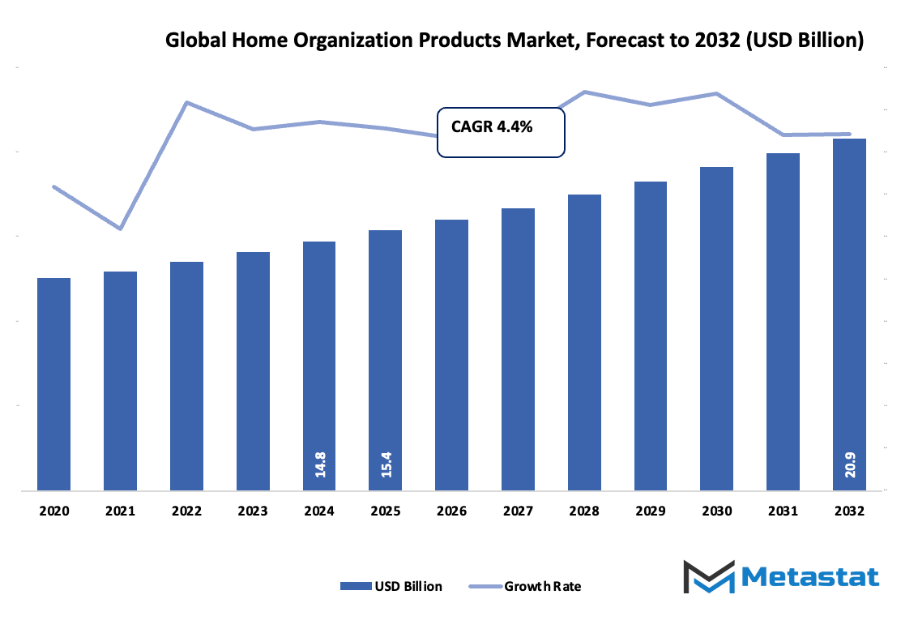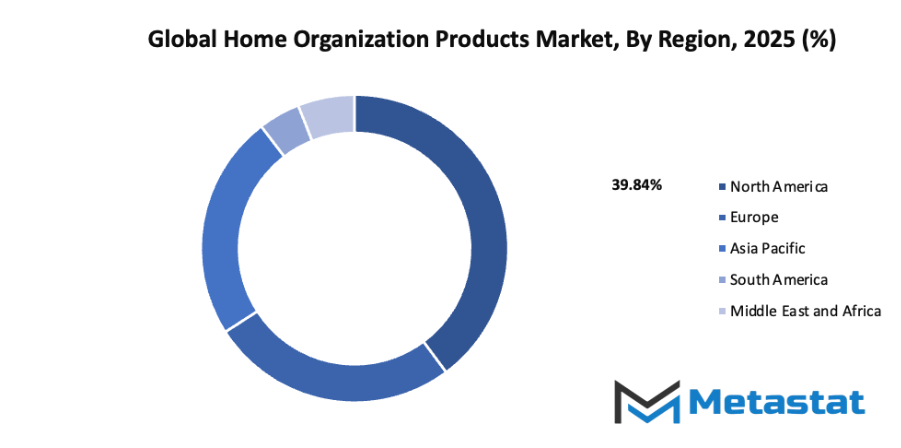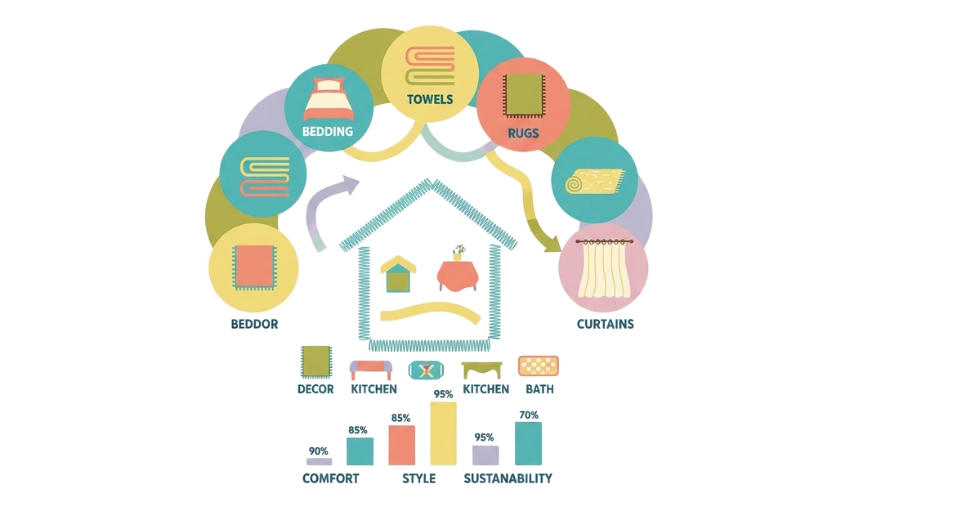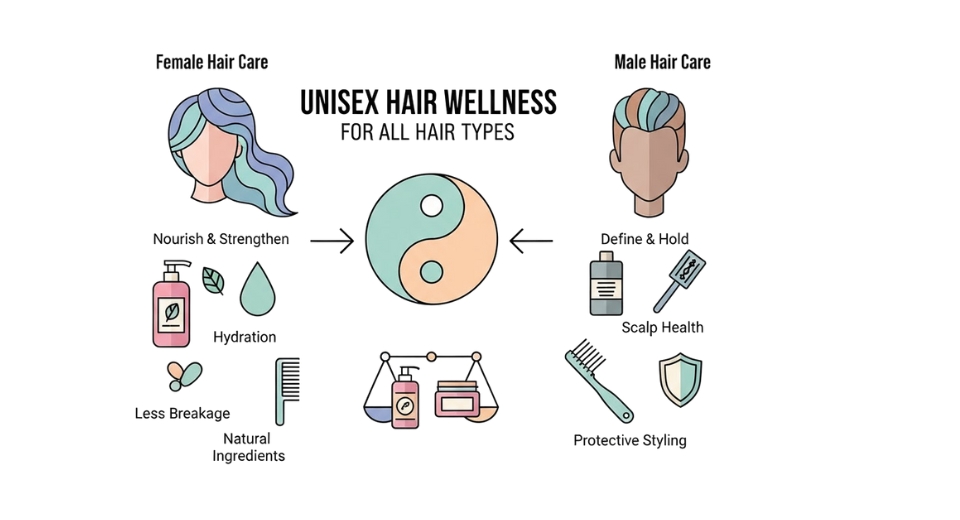Global Home Organization Products Market - Comprehensive Data-Driven Market Analysis & Strategic Outlook
The global home organization products market within the consumer goods sector will remain in the spotlight among households globally as lifestyles evolve and residential spaces adapt. Its roots can be traced back to the early 20th century when functional storage emerged in city residences in response to growing household items and confined living spaces. Firstly, the market itself was focused on minimalist shelving units, cabinets, and plain containers, with their primary focus being utility as opposed to aesthetics. With the growth of middle-class populations and the pace of urbanization, demands for those products that could merge function and fashion grew more evident, creating the first definitive point for the market.
- Global home organization products market size of around USD 15.4 Billion in 2025, expanding at a CAGR of around 4.4% until 2032, with potential to cross USD 20.9 Billion.
- Plastic accounts for almost 52.6% market share, fueling innovations and spreading uses through rigorous research.
- Growth-driving key trends: Expansion in urbanization resulting in compact living spaces and increased demand for effective storage solutions, Rise in customer desire for visually pleasing and functional home organization products
- Opportunities are: Increased uptake of intelligent and modular organizational systems coupled with IoT for contemporary households
- Key insight: The market will expand exponentially in value within the next ten years, with major growth opportunities.
- During the subsequent decades, the world home organization products market will undergo its revolution with the advent of modular systems and multi-functional furniture.

The 1970s and 1980s will be marked by the emergence of self-assembly storage solutions and the popularity of closet organizers, which enabled individualizing storage for numerous households. This time will also coincide with a greater emphasis on utilization of small spaces effectively, especially in urban agglomerations, which will drive the direction of product innovation. Technological innovation will continue to reshape the market, with products such as lightweight metals, long-lasting plastics, and intelligent storage becoming increasingly prevalent. Customers will want increasingly more products that not only organize but also support environmental responsibility and smart-home capabilities. Changes in regulations about environmental compliance will compel manufacturers to employ green materials and processes, putting pressure on what products become most shelf dominant. Digital platforms and e-commerce will be at the forefront of broadening access to the global market for home organization products. Online shopping will enable consumers to view a greater range of styles, sizes, and custom possibilities than previously, changing shopping habits. Social media movements promoting minimalism and structured living will increase consumer demand further, so products are both functional and functional for personal expression.
As the international home organization products market advances, it will further change with evolving lifestyles, technology advancements, and sustainability needs. The focus will grow even more on solutions providing efficiency, flexibility, and design attractiveness, making the market an essential part of contemporary household management and daily living.
Market Segments
The global home organization products market is mainly classified based on Material Type, Product Type, Application, Distribution Channel.
By Material Type is further segmented into:
- Plastic: Plastic will remain the leader in the global home organization products market because it's light and inexpensive. Improvements in green and recyclable plastics will contribute to making products environmentally friendly, hence appealing to consumers looking for convenience without destroying the environment. This product will always be a convenient option for multi-purpose home storage.
- Wood: Wood will retain its popularity within the global home organization products market as customers demand natural and handsome storage devices. Advanced finishes and treatments will enhance longevity, providing long-term furniture that balances functionality with grace. Wood will continue to satisfy both classic preferences and contemporary design styles within residences.
- Wire: Wire items will become increasingly popular among Home Organization Products in the global market due to their durability, flexibility, and accessibility of content. Designs in the future will incorporate corrosion-proof materials and modular designs, offering flexible storage compatible with changing home configurations. Wire storage will continue as a convenient option for structured and accessible space.
- Others: Other products in the global home organization products market will increase as producers test composites, metals, and fabrics. These products will offer distinctive qualities like light-weight strength and waterproofing. Invention will widen the range of alternatives, providing shoppers with options that integrate style, functionality, and long-term use.
By Product Type the market is divided into:
- Bins: Bins will remain a central component of the global home organization products market with flexible and stackable storage units. Future models will feature smart aspects like labeling systems and foldable structures that will assist homes in keeping themselves in order while adjusting to shrinking living spaces and shifting consumer demands.
- Baskets: Baskets will continue to be in vogue in the international Home Organization Products market for both style and utility. Baskets will change in terms of material and design to offer long-lasting fibers and collapsible versions, so they can be used across several rooms. Baskets will address the need for functional storage with a touch of beauty in contemporary homes.
- Shelving: Shelving will be a critical component in the global home organization products market, offering accessible and visible storage for everyday use. Modular and adjustable shelving designs will be future innovations that enable homeowners to personalize shelves for varying space and storage requirements while keeping their home neat and tidy.
- Modular Units: Modular units will propel progress in the global home organization products market because of their flexibility and multifaceted application. Customers will favor individualized setups which maximize space, are technologically integrated, and are fashionably styled. Modular units will keep revolutionizing storage by addressing changing home needs effectively.
- Hanging Storage: Hanging storage will grow in the world Home Organization Products market by taking full advantage of vertical space in small living spaces. Emerging designs will balance strength with style, offering flexible solutions for kitchens, bedrooms, and utility areas. Hanging storage will continue to be an intelligent means of keeping things in order while conserving floor space.
- Others: Other product categories in the global home organization products market will comprise distinctive and specialized storage solutions. Innovation will introduce adaptive, multi-functional products that respond to individual household needs, balancing convenience with contemporary style. These choices will provide assurance that storage solutions are able to work with varying home settings and changing consumer expectations.
By Application the market is further divided into:
- Bedrooms: Bedrooms will see continued demand in the global home organization products market for functional and stylish storage. Future trends will focus on space-saving solutions, including under-bed storage, modular closets, and organizers that enhance both accessibility and room aesthetics, helping maintain tidy and comfortable personal spaces.
- Garages: Garages will play a significant role in the market as consumers seek efficient organization of tools, equipment, and recreational items. Advanced modular systems and durable storage units will provide flexibility, making garages a well-organized extension of living areas while maintaining ease of access.
- Family Rooms: Family rooms will require versatile storage in the market to manage toys, electronics, and daily essentials. Future solutions will focus on multifunctional and attractive units that integrate storage seamlessly into living spaces, balancing style and practicality for busy households.
- Kitchens: Kitchens will continue to drive the market with products that optimize small and large spaces. Smart shelving, bins, and hanging systems will allow efficient storage of utensils and groceries, ensuring cleanliness and accessibility, while innovative designs cater to modern culinary needs.
- Utility Rooms: Utility rooms will demand practical storage solutions in the market. Future developments will include water-resistant, modular, and space-saving units, enhancing organization in laundry and cleaning areas. These products will ensure that utility spaces remain functional without clutter, adapting to growing home efficiency trends.
- Others: Other applications in the global home organization products market will include home offices, bathrooms, and outdoor spaces. Products will continue to evolve with flexible designs that accommodate various storage needs, supporting organized lifestyles in every part of the home while keeping adaptability and modern aesthetics in focus.
By Distribution Channel the global home organization products market is divided as:
- Online Retail: Online retail will continue to dominate the global home organization products market as digital platforms provide convenience, wider choices, and competitive pricing. Future trends will include augmented reality previews and personalized recommendations, making it easier for consumers to choose suitable storage products for their homes from anywhere.
- Specialty Stores: Specialty stores will maintain a strong presence in the market, offering expert guidance and curated selections. Future developments will focus on experiential shopping, where customers can explore products in real-life settings, enhancing satisfaction and confidence in selecting effective home organization solutions.
- Supermarkets And Hypermarkets: Supermarkets and hypermarkets will remain important in the market, providing easy access to essential storage items alongside daily shopping. Innovations will include dedicated sections with organized displays and bundled products, supporting impulse buying and convenience-driven consumer behaviour.
- Others: Other distribution channels in the global home organization products market will include direct-to-consumer models, pop-up stores, and subscription services. These channels will expand as businesses adapt to changing consumer habits, providing creative ways to reach buyers with convenient, personalized, and innovative storage solutions.
|
Forecast Period |
2025-2032 |
|
Market Size in 2025 |
$15.4 Billion |
|
Market Size by 2032 |
$20.9 Billion |
|
Growth Rate from 2025 to 2032 |
4.4% |
|
Base Year |
2024 |
|
Regions Covered |
North America, Europe, Asia-Pacific, South America, Middle East & Africa |
By Region:
- Based on geography, the global home organization products market is divided into North America, Europe, Asia-Pacific, South America, and the Middle East & Africa.
- North America is further divided into the U.S., Canada, and Mexico, whereas Europe consists of the UK, Germany, France, Italy, and the Rest of Europe.
- Asia-Pacific is segmented into India, China, Japan, South Korea, and the Rest of Asia-Pacific.
- The South America region includes Brazil, Argentina, and the Rest of South America, while the Middle East & Africa is categorized into GCC Countries, Egypt, South Africa, and the Rest of the Middle East & Africa.

Growth Drivers
- Rising urbanization leading to smaller living spaces and higher demand for efficient storage solutions: Rapid urban development has caused living spaces to become more compact, increasing the need for efficient storage options. Households will increasingly look for products that maximize space utilization while maintaining functionality, driving growth in the market.
- Increasing consumer preference for aesthetically appealing and multifunctional home organization products: Modern consumers will prefer products that combine style and utility. The demand for home organization items that not only organize but also enhance interior design will push manufacturers to innovate, supporting the expansion of the global home organization products market.
Challenges
- Availability of low-cost unorganized alternatives affecting premium product sales: The presence of inexpensive alternatives will limit the growth of premium segments. Consumers may opt for cheaper options even if quality and design are compromised, which could slow the revenue growth of higher-end products in the market.
- Fluctuations in raw material costs impacting manufacturing and pricing: Changes in the cost of raw materials will directly affect production expenses and product pricing. Manufacturers may face challenges in maintaining consistent pricing without affecting profit margins, posing a potential hurdle for the global home organization products market.
Opportunities
Growing adoption of smart and modular organization systems integrated with IoT for modern households: Advancements in technology will lead to wider adoption of smart storage solutions. Modular and IoT-enabled products that adapt to user needs will create new opportunities, drive innovation and shaping the future growth of the global home organization products market.
Competitive Landscape & Strategic Insights
The global home organization products market is steadily gaining importance as households increasingly seek practical and aesthetically pleasing solutions to manage living spaces. This market includes a wide range of products designed to help people store, arrange, and optimize the use of their homes. As urban spaces become more compact and lifestyles grow busier, the demand for innovative storage solutions continues to rise. The industry features a combination of established international companies and emerging regional players, which creates a dynamic competitive environment. Important competitors in the global home organization products market include ClosetMaid, GarageTek Inc., KOLORR, Houzz Inc., Inter IKEA Systems B.V., Iris USA, Inc., Lowe’s, Rubbermaid, Myers Industries, Inc. (Akro-Mils), ORG Home, Organized Living, Whitmor, Staples Inc., Sterilite Corporation, storeWALL, Rev-A-Shelf LLC, Honey-Can-Do International, Tupperware Brands Corporation, Spectrum Diversified Designs, LLC., Knape & Vogt Manufacturing Company, and Häfele America Co.
The market is expected to grow significantly in the coming years as smart storage solutions and multifunctional products gain popularity. Integration of technology into storage products, such as adjustable shelves with sensors, modular units that adapt to changing needs, and digital inventory management systems, will likely shape the future of home organization. Consumers are increasingly looking for solutions that not only save space but also enhance efficiency and lifestyle convenience. This trend will encourage companies in the global home organization products market to invest in research and development, designing products that are both functional and stylish.
Regional differences will continue to play a major role in shaping market growth. While established companies maintain a strong presence through brand recognition and distribution networks, regional competitors are likely to challenge them by offering innovative, cost-effective solutions tailored to local preferences. Sustainability will also become an important factor, with products designed from eco-friendly materials and packaging gaining favour among environmentally conscious consumers.
Market size is forecast to rise from USD 15.4 Billion in 2025 to over USD 20.9 Billion by 2032. Home Organization Products will maintain dominance but face growing competition from emerging formats.
Overall, the global home organization products market is moving toward a future where smart, adaptable, and eco-conscious products will dominate. Both international leaders and emerging competitors will play critical roles in driving innovation, improving accessibility, and shaping the way households organize their living spaces in years to come.
Report Coverage
This research report categorizes the global home organization products market based on various segments and regions, forecasts revenue growth, and analyzes trends in each submarket. The report analyses the key growth drivers, opportunities, and challenges influencing the global home organization products market. Recent market developments and competitive strategies such as expansion, type launch, development, partnership, merger, and acquisition have been included to draw the competitive landscape in the market. The report strategically identifies and profiles the key market players and analyses their core competencies in each sub-segment of the global home organization products market.
Home Organization Products Market Key Segments:
By Material Type
- Plastic
- Wood
- Wire
- Others
By Product Type
- Bins
- Baskets
- Shelving
- Modular Units
- Hanging Storage
- Others
By Application
- Bedrooms
- Garages
- Family Rooms
- Kitchens
- Utility Rooms
- Others
By Distribution Channel
- Online Retail
- Specialty Stores
- Supermarkets And Hypermarkets
- Others
Key Global Home Organization Products Industry Players
- ClosetMaid
- GarageTek Inc.
- KOLORR
- Houzz Inc.
- Inter IKEA Systems B.V.
- Iris USA, Inc.
- Lowe’s.
- Rubbermaid
- Myers Industries, Inc.(Akro-Mils)
- ORG Home
- Organized Living
- Whitmor
- Staples Inc.
- Sterilite Corporation
- storeWALL
- Rev-A-Shelf LLC
- Honey-Can-Do International
- Tupperware Brands Corporation
- Spectrum Diversified Designs, LLC.
- Knape & Vogt Manufacturing Company
- Häfele America Co.
WHAT REPORT PROVIDES
- Full in-depth analysis of the parent Industry
- Important changes in market and its dynamics
- Segmentation details of the market
- Former, on-going, and projected market analysis in terms of volume and value
- Assessment of niche industry developments
- Market share analysis
- Key strategies of major players
- Emerging segments and regional growth potential








 US: +1 3023308252
US: +1 3023308252






